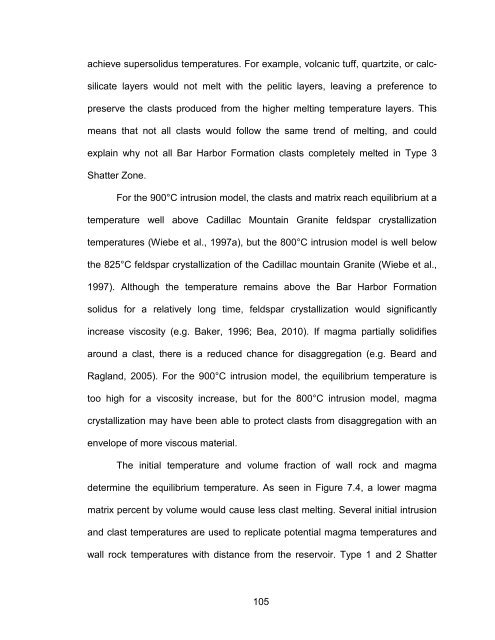You also want an ePaper? Increase the reach of your titles
YUMPU automatically turns print PDFs into web optimized ePapers that Google loves.
achieve supersolidus temperatures. For example, volcanic tuff, quartzite, or calcsilicate<br />
layers would not melt with the pelitic layers, leaving a preference to<br />
preserve the clasts produced from the higher melting temperature layers. This<br />
means that not all clasts would follow the same trend <strong>of</strong> melting, and could<br />
explain why not all Bar Harbor Formation clasts completely melted in Type 3<br />
Shatter Zone.<br />
For the 900°C intrusion model, the clasts and matrix reach equilibrium at a<br />
temperature well above Cadillac Mountain Granite feldspar crystallization<br />
temperatures (Wiebe et al., 1997a), but the 800°C intrusion model is well below<br />
the 825°C feldspar crystallization <strong>of</strong> the Cadillac mountain Granite (Wiebe et al.,<br />
1997). Although the temperature remains above the Bar Harbor Formation<br />
solidus for a relatively long time, feldspar crystallization would significantly<br />
increase viscosity (e.g. Baker, 1996; Bea, 2010). If magma partially solidifies<br />
around a clast, there is a reduced chance for disaggregation (e.g. Beard and<br />
Ragland, 2005). For the 900°C intrusion model, the equilibrium temperature is<br />
too high for a viscosity increase, but for the 800°C intrusion model, magma<br />
crystallization may have been able to protect clasts from disaggregation with an<br />
envelope <strong>of</strong> more viscous material.<br />
The initial temperature and volume fraction <strong>of</strong> wall rock and magma<br />
determine the equilibrium temperature. As seen in Figure 7.4, a lower magma<br />
matrix percent by volume would cause less clast melting. Several initial intrusion<br />
and clast temperatures are used to replicate potential magma temperatures and<br />
wall rock temperatures with distance from the reservoir. Type 1 and 2 Shatter<br />
105
















